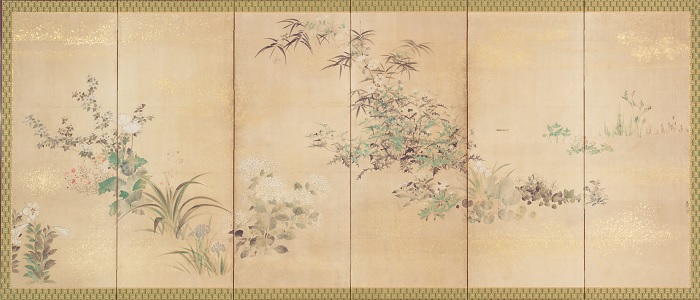
Kitagawa Sosetsu
Japanese, 17th c. CE, mid
Spring and Autumn Flower and Grasses, n.d.
ink, color, and gold on paper; pair of six-panel folding screens
61 1/4 x 114 in.
SBMA, Museum purchase with funds provided by Wright S. Ludington
1962.21.1-2
COMMENTS
Kitigawa Sōsetsu ... painted numerous renderings of flowers in a style that differs greatly from the paintings of Tawaraya Sōtatsu and his predecessors who painted "Inen" flower screens. Kitigawa Sōsetsu arranged his relatively naturalistic floral themes on grounds of light ink on blank paper, enveloped by mist rendered in monochrome ink. When he painted blossoms, Sōsetsu employed bright neutral colors; when he rendered leaves, he used ink, malachite, and sometimes indigo, among other pigments, illustrating the breadth of his color palette. Ink, however, forms the basis of Sōsetsu's painting of leaves, exemplifying the somber elegance that lies at the core of his works. ...
- Takeshi Noguchi, Kitigawa Sōsetsu and the Formation of his Style, Journal of the Japan Art History Society, vol. 64, no. 2, p.178
SBMA CURATORIAL LABELS
Sōsetsu was the foremost pupil of the Rinpa school founder, Tawaraya Sōtatsu (1570–1643), active in the imperial capital Kyoto. In about 1642, Sōsetsu moved to Kanazawa and established a branch of the Rinpa school. In deference to the botanical avocation of the lord of that fiefdom, Sōsetsu devoted himself to painting flowers. Asymmetrical composition, absence of harsh outlines, and dripping ink or color onto wet pigment were features of the Rinpa style carried on by Sōsetsu, who combined mineral pigments and water-based colors with black ink within a composition. Sōsetsu is additionally noted for his realistic treatment of plants and their relation to one another.
The plants are arranged seasonally from right to left: early spring to late summer on the right screen and the scattered "seven grasses of autumn" on the left. Sprinkled gold suggests lingering morning mist. These screens would have resided in the home of a noble or samurai with poetic proclivities.
- Paths to Gold, 2018

